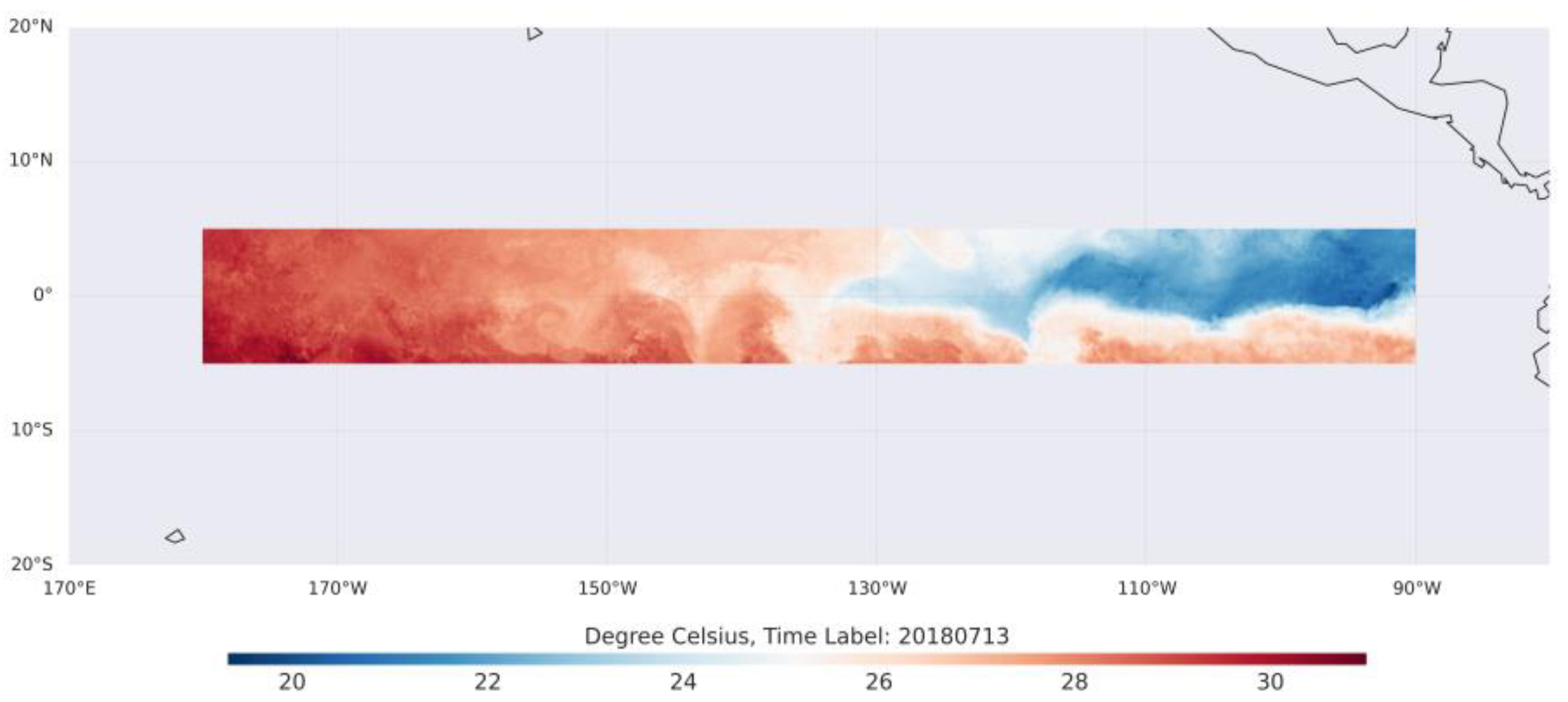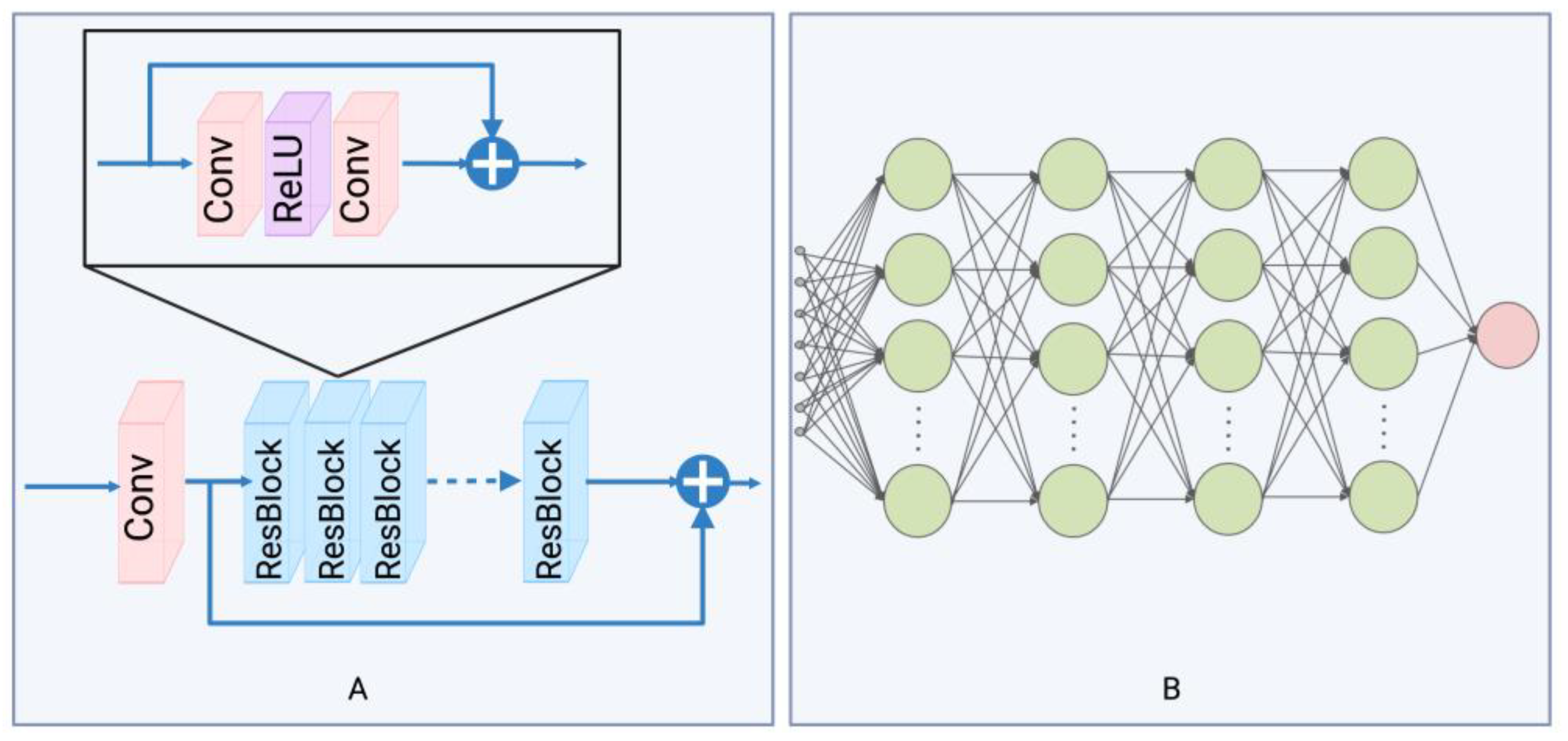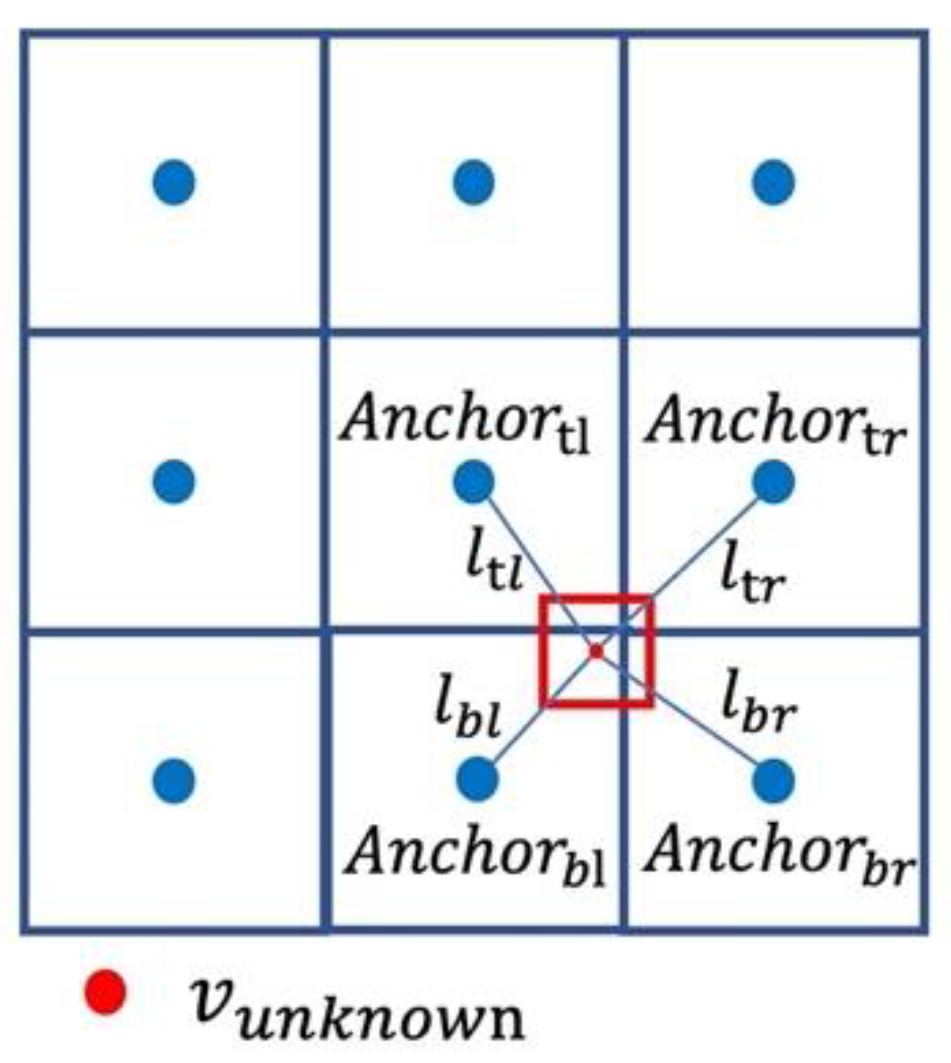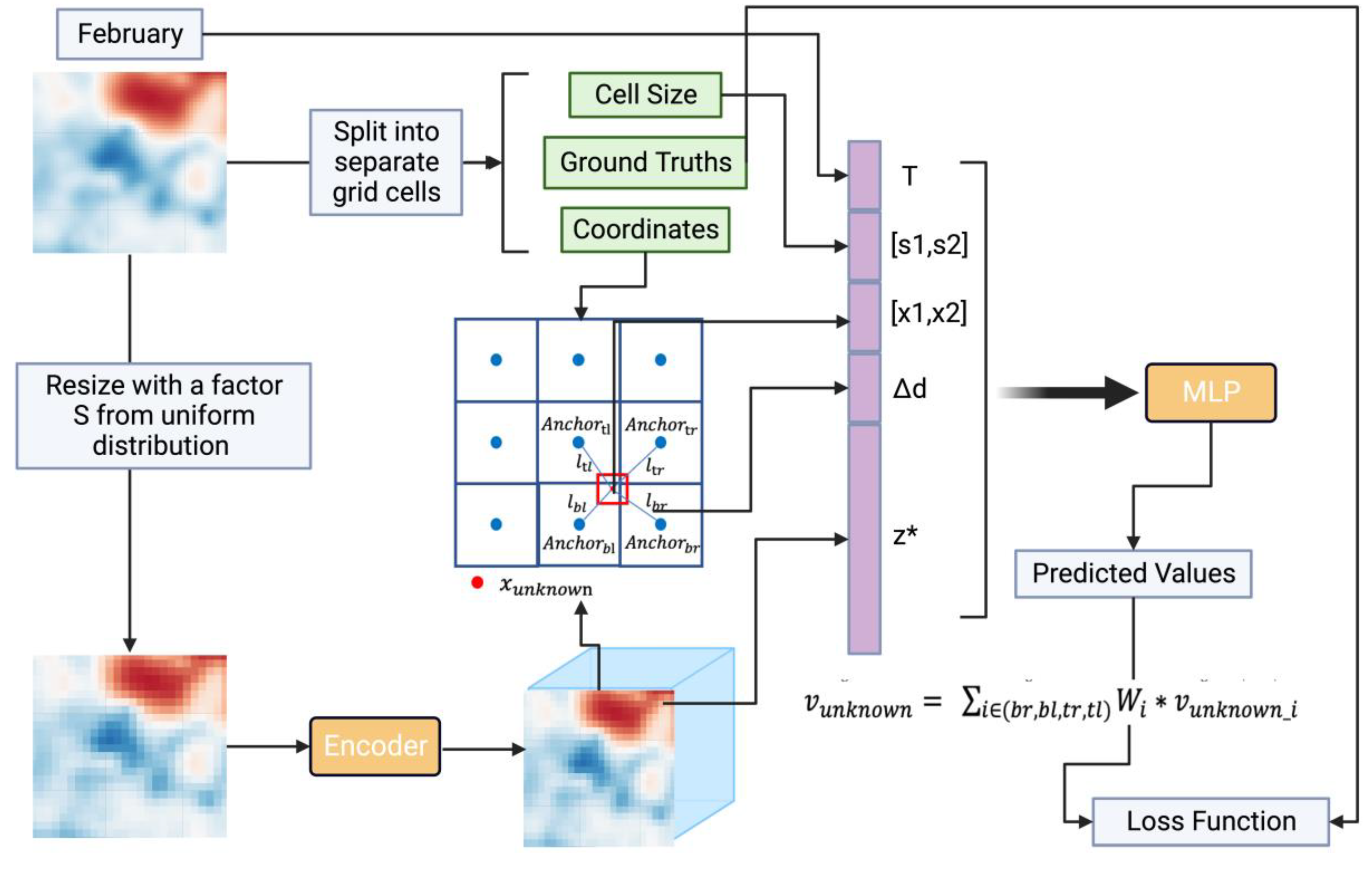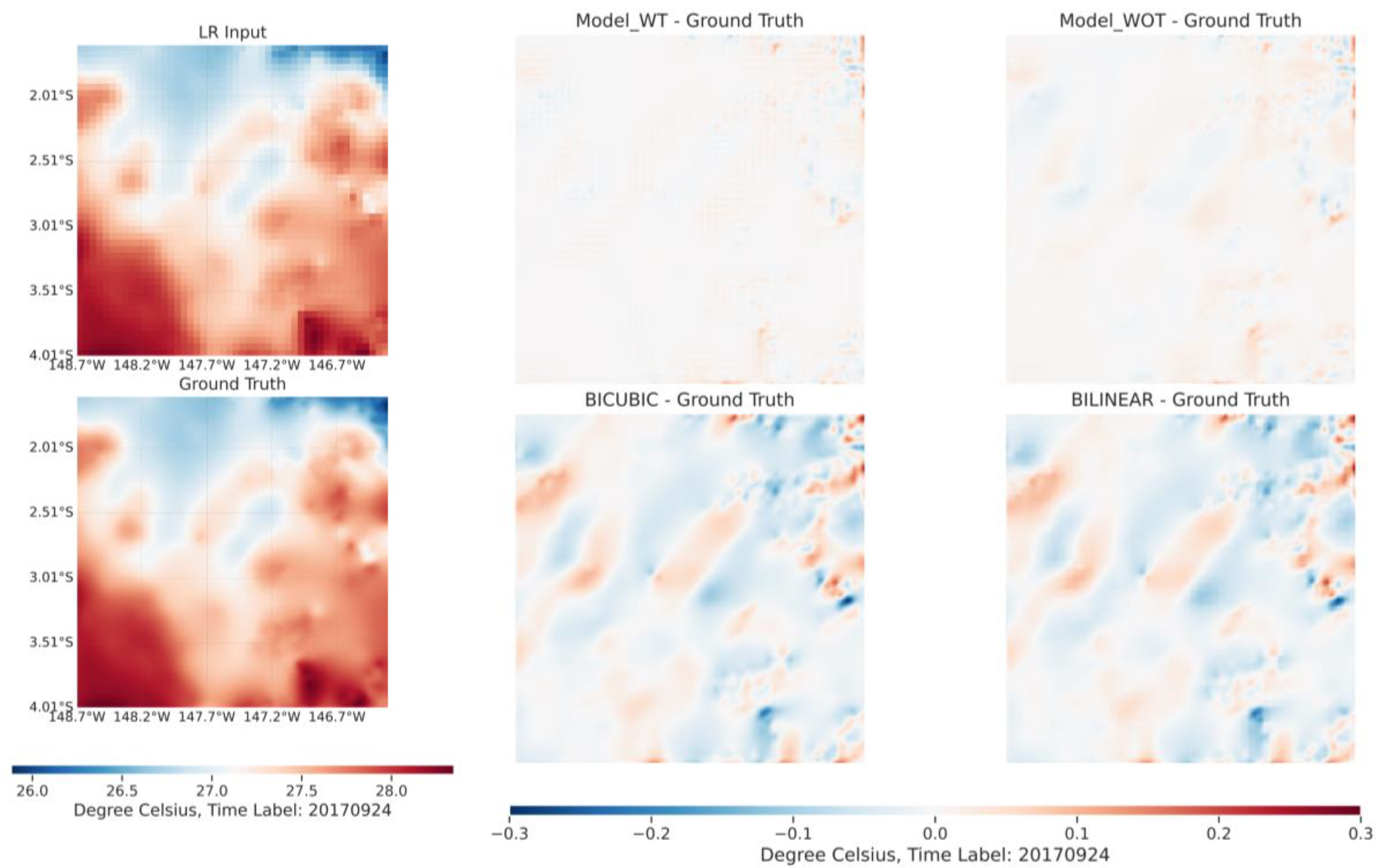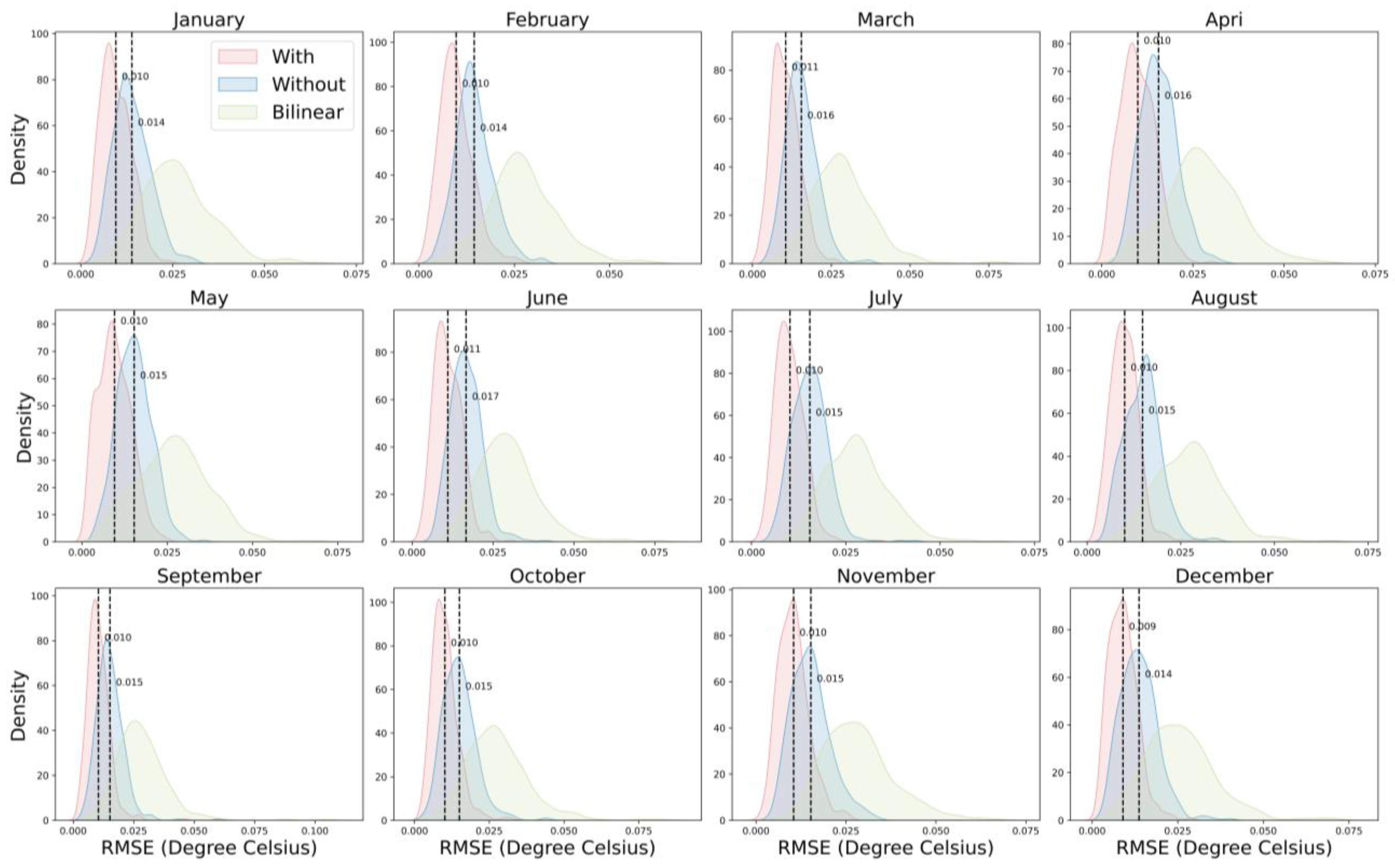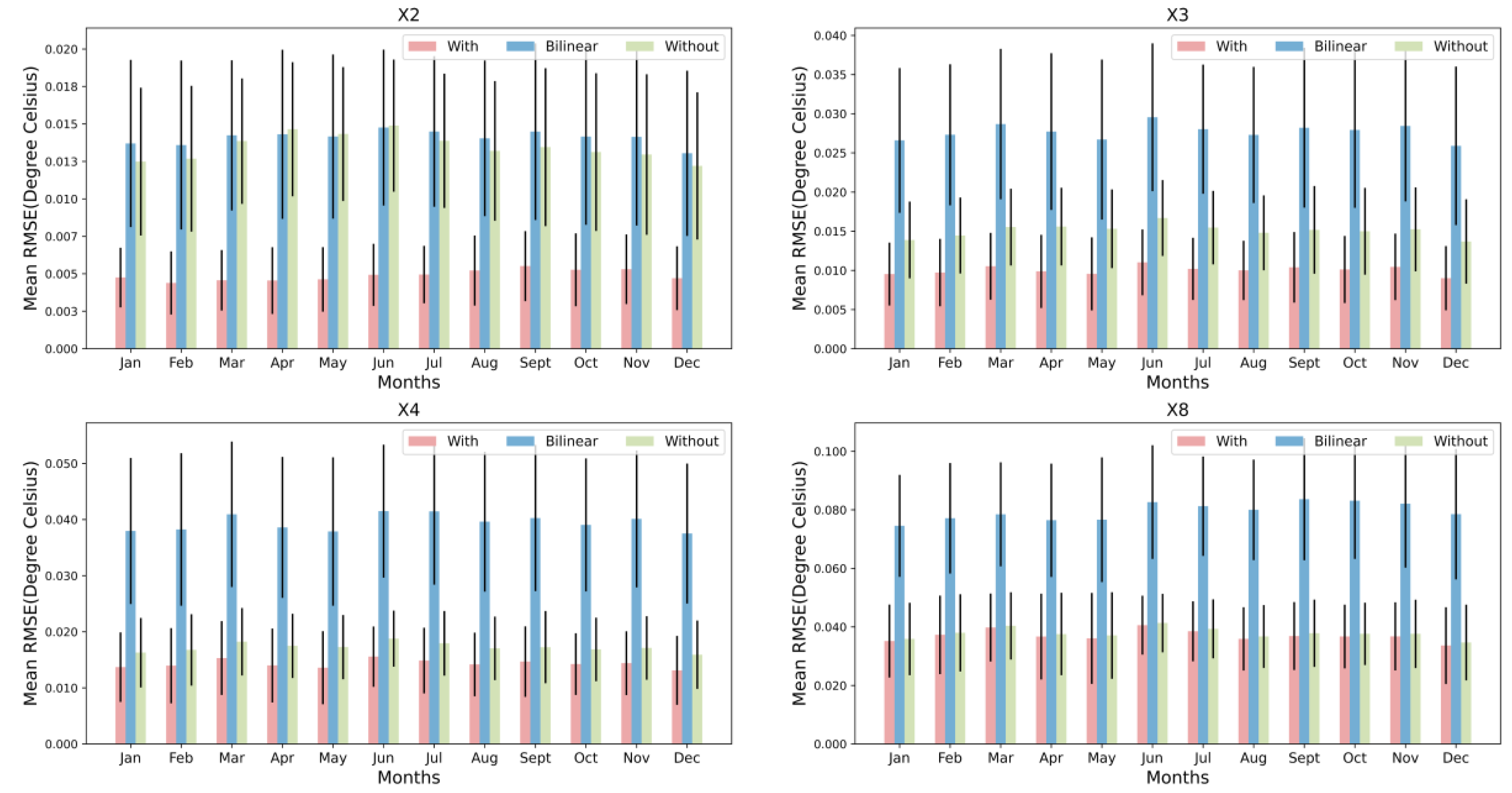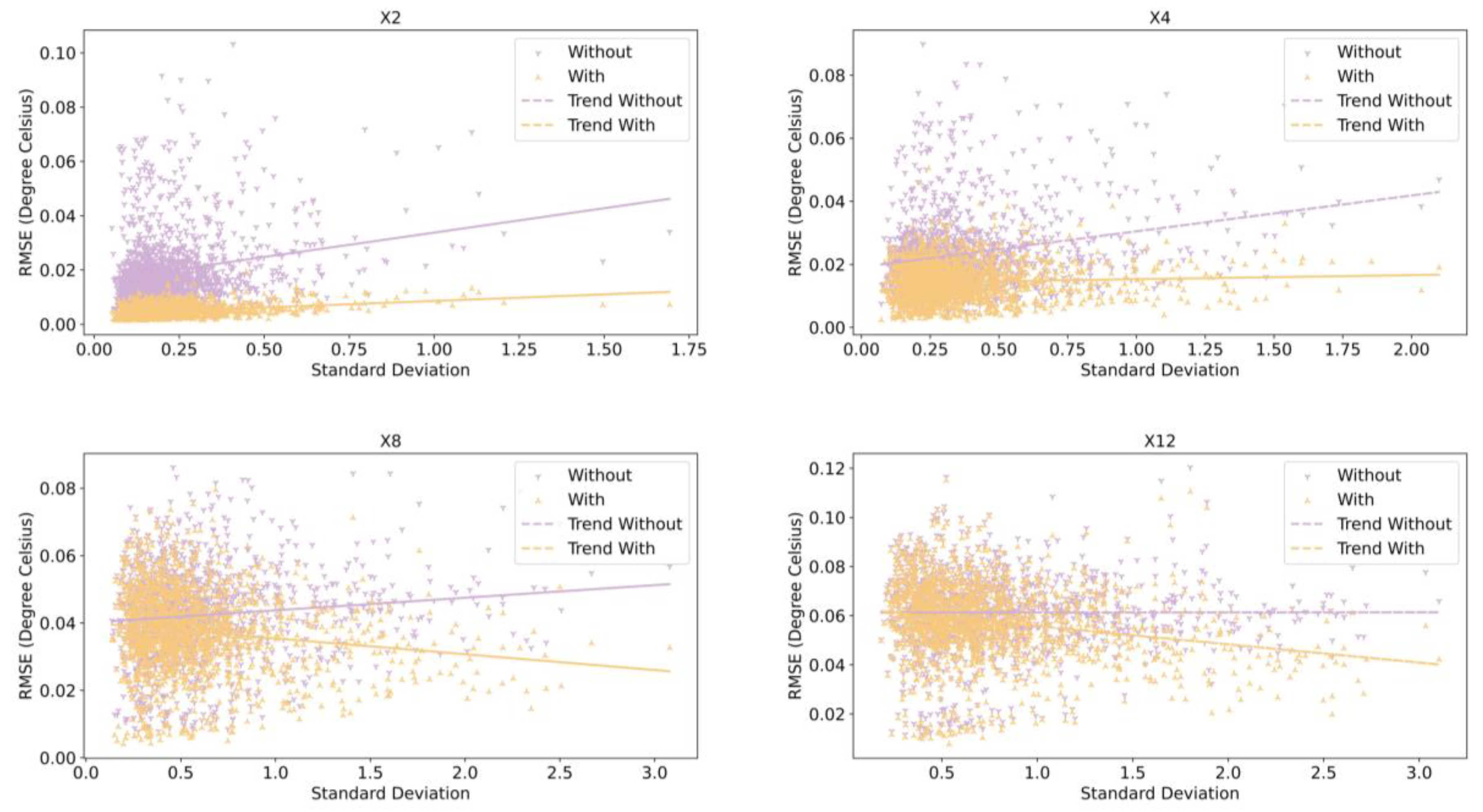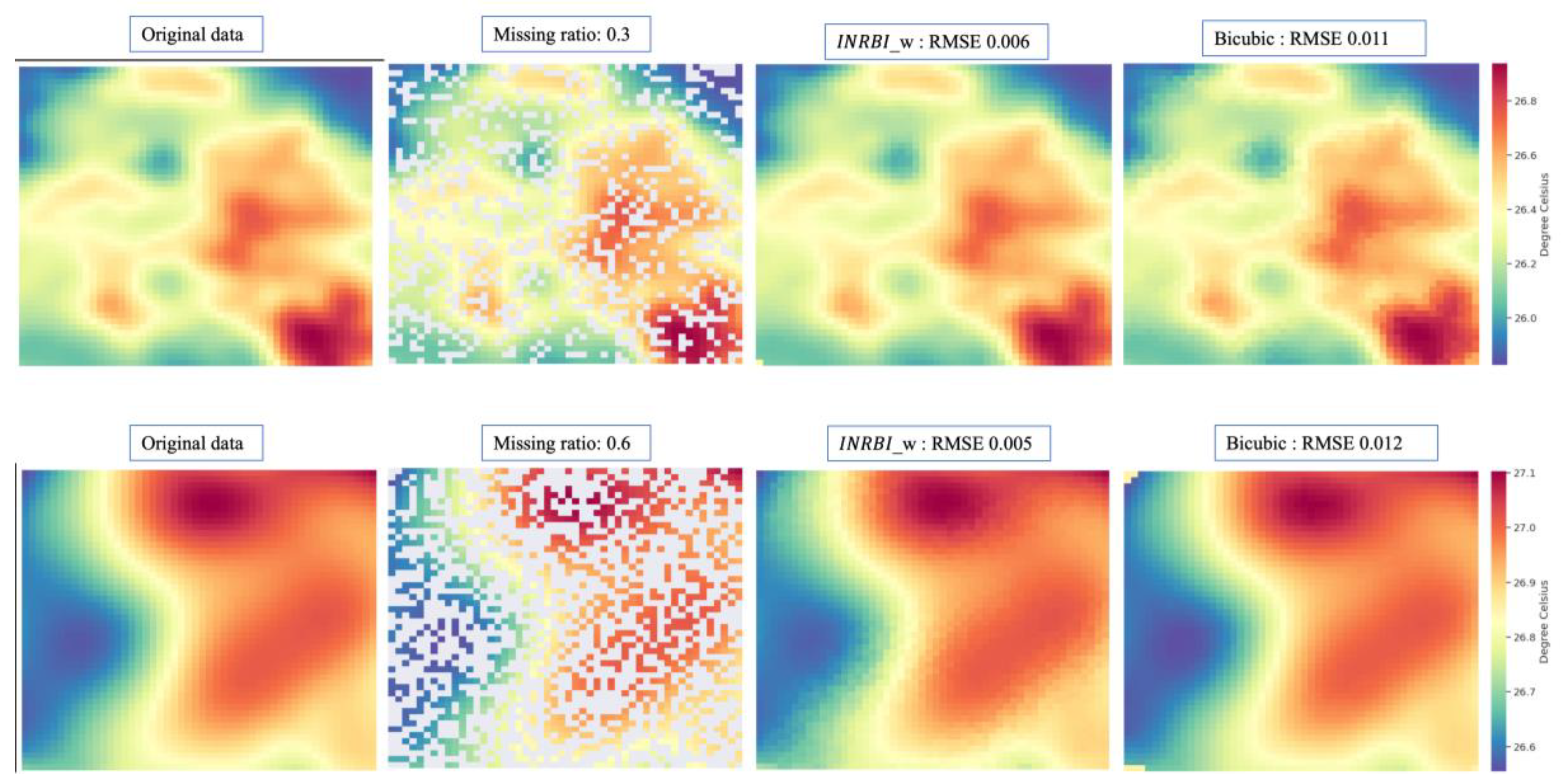method is not limited to the enhancement scale provided during the training process and its results indicate that it can enhance low-resolution input by arbitrary scale. Additionally, we discuss the impact of temporal information on the generation of high-resolution climate data, specifically, which month the low-resolution sea surface temperature data is from. Our experimental results indicate that is advantageous over traditional interpolation methods under different enhancement scales, and the temporal information can improve performance for a different calendar month. We also examined the potential capability of in recovering missing grid value. These results demonstrate that the proposed is a promising method for generating high-resolution climate data and has significant implications for climate research and related applications.
1. Introduction
EI Niño-Southern Oscillation (ENSO) is the strongest signal of interannual variability in the climate system. Research on ENSO is crucial for understanding the complex interactions between the oceans, atmosphere, and climate, as well as for developing strategies to mitigate the potential impacts of climate variability and change because it not only directly causes extreme weather events such as droughts in the tropical Pacific and its surrounding areas, but also indirectly affects the weather and climate in other parts of the world through teleconnections, triggering meteorological disasters [
1,
2,
3]. Currently, many studies have been conducted to investigate the teleconnections of ENSO and its predictive capabilities regarding other climate factors [
4,
5,
6,
7]. In these studies, ENSO is typically described by various indices, which are mainly calculated based on sea surface temperature (SST) in different regions. For instance, the calculation of the NINO 3.4 index is primarily based on SST in the range of 170 °W-120 °W and 5 °S-5 °N.
In recent years, related research has gone beyond the use of scalar indices such as NINO 3.4 to characterize ENSO. On one hand, the use of scalar indices often leads to a loss of information on the spatial distribution of SST, which may be critical in understanding the relationship between ENSO and other climate factors. On the other hand, recent ENSO events have shown strong anomalies in SST regions within the subtropical Pacific that are different from the traditional regions [
8]. The limitations of scalar indices in capturing the full complexity of ENSO dynamics have spurred interest in alternative methods for describing ENSO events. For example, some studies have used empirical orthogonal functions of SST in the Pacific Ocean as indices, rather than NINO3.4 [
9]. Others have employed a non-homogeneous hidden Markov model (NHMM) to simulate the monthly-scale tropical Pacific SST and defined five different hidden states for each month [
10]. Prior work[
8] uses this approach to investigate the potential predictive power of the five hidden states on global rainfall.
Commonly used SST data are climate model outputs or satellite-derived data. The accuracy and richness of information in these grid-type representations are controlled by their resolution. Not only SST data, high-resolution (HR) climate data are of great significance for climate simulations, agriculture, and other fields. Traditional methods for obtaining HR climate data mainly rely on interpolation, such as bicubic and bilinear interpolation [
11]. These methods do not require training data, but often result in over-smoothed outcomes. With the development of deep learning techniques, an increasing number of deep learning models have been applied to generate HR climate data and address the issue of over-smooth in the process. For example, Vandal et al. [
12] used Super-Resolution Convolutional Neural Networks (SRCNN) to generate HR rainfall data. Ducournau et al. [
13] also used SRCNN to increase the resolution of satellite-derived SST data. Stengel et al. [
14], based on SRGAN, enhanced the resolution of wind and solar data by a factor of 50. Wang et al. [
15] explored the applicability of SinGAN in generating HR climate data. However, a common limitation of these models is that their enhancement scales are fixed. Once trained, they can only be used for reconstructing HR data at a pre-defined gridded structure, whereas the climate analysis often require HR data at arbitrary locations over different scales.
To overcome this limitation, we propose to develop a new approach for continuous HR data reconstruction based on the Implicit Neural Representation (INP) method [
16,
17]. The idea is to represent an object as a multi-layer perceptron (MLP) that maps coordinate to signals. It has been extensively used in 3D tasks, such as simulating 3D surfaces [
18,
19] or structures [
20,
21]. INP is also widely used in research on image reconstruction [
22,
23,
24]. One improvement to this approach is to use a encoder to construct a shared feature space that can be used to represent every sample with an implicit representation [
25,
26]. For example, Chen et al. [
27] constructed a continuous image representation using implicit neural representation to overcome the limitation of implicit sample-specific neural representation.
In this study, we introduce an interpolation method that integrates temporal information based on implicit neural representation (). By fusing deep learning models with interpolation technique, this method can produce HR climate data at arbitrary scales. After model's training, our method is capable of not only enhancing the resolution based on the scales used during training but also enhancing the resolution of climate data based on scales not seen in the training phase. While implicit neural representations have proven successful in 3D and image tasks, their application in climate research has yet to be explored. This paper addresses this gap by focusing on a specific use case: reconstructing HR SST data from low-resolution (LR) samples. We regard the reconstructing HR SST data as a problem of estimating unknown values (HR sample positions) based on known values (LR sample positions). Within the proposed interpolation approach, LR SST samples undergo an encoding process to attain corresponding implicit neural representations for each grid cell. These representations act as anchors for predicting the values at positions in the HR result. The method establishes a relationship between the implicit neural representations at these anchor sites and unknown positions, factoring in grid size, central point coordinates, and other parameters. A decoder then infers the values at these unknown positions, yielding a comprehensive HR climate data result. Additionally, we incorporate temporal information, specifically the calendar month during which samples are acquired. The model employs one-hot encoding to capture the sample's calendar month and leverages a learnable matrix to enhance its capability to process intricate temporal information. Our results suggest that the proposed interpolation method outperforms conventional interpolation methods at different enhancement scales. Compared to CNN-based approaches for generating HR climate data, the proposed method's advantage lies in its flexibility. Comparisons between results with and without temporal information underscore the merit of incorporating temporal information, as it elevates the quality of the generated HR SST data. Additionally, we explore the method's potential in recovering missing data by setting the enchantment scale to be 1.
The paper’s contributions are: (1) introducing a novel interpolation method based on implicit neural representation which, after training, can provide arbitrary HR SST climate data; (2) embedding temporal information into the process of generating HR SST climate data and demonstrating its effectiveness.
The paper is organized as follows.
Section 2 describes the data used in the study and
Section 3 introduces the details of the proposed
method and the network setup.
Section 4 discuss the results.
Section 5 gives conclusions and discusses future research directions.
2. Dataset
We use the GHRSST Level 4 MUR Global Foundation Sea Surface Temperature Analysis dataset (MUR SST) in our experiments [
28]. MUR SST is one of the current highest-resolution SST analysis datasets, providing global daily SST from May 31, 2002 to the present. The spatial resolution of MUR SST is
, roughly at 1 km intervals. MUR SST combines three types of satellite SST datasets: HR infrared SST data of about 1 km, medium-resolution AVHRR (infrared) SST data of 4 to 8.8 km, and microwave SST data with a sampling interval of 25 km [
29]. In addition to these three satellite derived data, MUR also assimilates two types of in-situ SST measurements to enhance the estimation of the underlying temperature. Due to computational burden of using the entire dataset, we extracted the SST in the region 180°W-90°W and 5°S-5°N as the study area, shown in
Figure 1. The daily sample from June 1, 2002 to December 31, 2016 serves as the training data for the model, while the daily data from January 1, 2017 to December 31, 2022 with a total of 2188 samples serves as the validation dataset. For testing, in addition to the MUR SST validation dataset described above, we also report results for MUR SST Monthly Mean dataset as a external validation. MUR SST Monthly Mean dataset is created by NOAA NMFS SWFSC ERD based on the GHRSST Level 4 MUR SST daily dataset mentioned above. It has the same spatial resolution as daily data. We use the same study area as the one used for the MUR SST dataset. The MUR SST Monthly Mean dataset is comprised of monthly samples spanning from 2003 to 2020.
3. Method
3.1. Overview of Proposed Method
The essence of obtaining HR climate data using interploation based method is to derive the climate values of HR grid cells based on the values of LR grid cells. Traditional spatial interpolation methods are based on information from the original data domain. For example, bicubic interpolation computes the value of an unknown grid cell by taking the weighted average of the surrounding 16 grid cells. In our proposed method, instead of directly interpolating from the original data domain, the interpolation occurs in the implicit representation domain. Essentially, the model is comprised of two parts: building implicit representation domain and interpolation. We first introduce the two deep learning models employed in this method, and then provide a detailed description of the specific steps within the proposed method.
3.2. Enhanced Deep Super-Resolution Network and Multilayer Perceptron
The proposed method integrates two distinct deep learning architectures. The first architecture is from the Enhanced Deep Super-Resolution Network (EDSR) [
30], and we use the initial segment before the upsample layer, as depicted in
Figure 2A. Within our method, EDSR is constructed with a convolutional layer, succeeded by 16 residual blocks. The addition of multiple residual blocks equips the network with the capability to discern complex patterns from the training process. Each of these blocks consists of convolutional layers, succeeded by a ReLU activation function. The essence of these residual blocks is to ascertain the residual between the input and output, eschewing direct output learning. This design implies that the network predominantly learns variations from identity mapping, promoting training stability. We utilize this structure as an encoder to transition the input data from its original data domain to an implicit representation domain. Rather than modifying the spatial dimensions of the input, the encoder enhances the depth at each location, yielding this implicit representation. The second architecture is a five-layer multilayer perceptron (MLP), depicted in
Figure 2B. Each hidden layer processes inputs from its preceding layer, undergoes a weighted summation, and produces outputs via the ReLU activation function. In our design, the hidden layers possess a dimensionality of 256, with the output layer dimensioned at 1. This MLP, in our method, functions as a decoder, determining the value at a specific location based on relevant input information.
3.3. Implicit Neural Representation Based Interpolation with Temporal Information
3.3.1. Implicit Neural Representation Based Interpolation
An implicit representation domain is achieved through the utilization of convolutional neural network-based encoder, which outputs the feature map and retains the same size as the input sample. At each location in the input sample, the corresponding feature vector constitutes the implicit representation of that location. Each grid cell can be represented by its centre position. We hypothesize that the value of each grid cell in the sample can be obtained by inputting the grid cell's implicit representation, coordinates, and size into a decoder:
where
represents the implicit representation of the target position, and
represents the coordinates of the center point of the grid.
is the decoder, which is the MLP we described in section 3.2. We assume that the implicit representation is uniformly distributed in the feature map domain, so the value of the grid cell at an arbitrary location in the domain can be obtained through the following function
:
where
is the implicit representation of the nearest known grid to the predicted unknown grid,
represents the length and width of the unknown grid,
represents the coordinates of the center of the unknown grid, and
is the euclidean distance between the two grids which is calculated by:
The model represents the length and width of the grid through
and
, thus providing the information of grid size. We take grid size into consideration because grids of different sizes might share the same central point. However, grids of varying sizes often represent distinct values due to the differences in the areas they cover. By incorporating information about grid size, we enhance the decoder's ability to differentiate situations with the same grid center but differing resolutions. For HR climate data projection task, the implicit representation of each grid cell in the LR input data can be obtained through a shared encoder among all samples. Every grid cell with implicit representation in the LR input can be used as anchor point for generating the corresponding HR data. In
Figure 3, blue grid cells represent LR input data, and the values of red grid cells which represent one grid cell of HR data can be obtained by the nearest anchor points
and Equation 2.
However, based on the First Law of Geography: the closer the points are in space, the higher the probability they have similar feature values, and the farther the points are, the lower the probability they have similar feature values. For any unknown grid cell, we can compute its vaule in the latent feature domain based on its nearest grid cell at the coarse resolution. However, this way remains limited as it ignores the valuable information from other surrounding known grids. Furthermore, just using one nearest anchor point can result in discontinuous patterns in the generated HR output because the anchor point (i.e., the nearest grid cell) might abruptly shift from one to another when the target grid cell moves gradually over space. The proposed method eliminates the discontinuity of the result through the weighted average of interploated results from multiple anchor points around the unknown grid cell, where the weights are based on the distance between anchor points and the target grid cell.
We consider the four points around the unknown grid as anchor points. As seen in
Figure 3, they are located at points
,
,
, and
, respectively, on the upper left, upper right, lower left, and lower right of the unknown grid cell.
first obtains the interpolation results
based on each anchor point for the unknown grid through Equation 2. Then, the final prediction value of the unknown grid is obtained by weighed average of the four results according to the inverse distance.
where
represents the distance between the center of the unknown grid cell and each of the four anchor points.
3.3.2. Temporal Information Embedding
The process of getting HR data from LR counterpart is commonly considered to be an ill-posed problem, as one LR pattern can correspond to multiple different HR patterns, and the model's training process tries to average all plausible solutions. In this LR to HR projection process, additional information is considered to be useful, as it helps the model choose the most appropriate HR pattern among all plausible solutions. For example, in the case of climate data such as sea surface temperature, temporal information, i.e., the time period the sample was taken from, can be utilized. Climate variables may exhibit a relatively uniform spatial distribution at one time period and a non-uniform distribution at another time period, and these two different HR data may correspond to the same LR sample. Adding temporal labels helps the model lock onto the most appropriate HR solution. In our research, the calendar month from which a SST sample was taken was considered as temporal information. Our hypothesis is that HR SST samples from different months (e.g., January and July) can correspond to the same LR sample. By providing the LR sample’s calendar month information, the model can more robustly find the corresponding HR pattern by using implicit neural representation.
In order to handle temporal information, the calendar month of each sample is first encoded as a 12-dimensional one-hot vector. The vector consists of 0s in all cells with only one cell with a value of 1 uniquely identifying the calendar month of the sample. This one-hot vector is then projected into an
dimensional embedding space by multiplying it with a learned parameter matrix
, as follows:
where
is a vector representing the temporal information of a sample,
is a learnable matrix, and
is a one-hot vector. The updated version of Equation 2 is:
3.4. Training and Setup
In this section, we discuss the training procedure of
.
Figure 4 shows how
works and its training steps. Our main goal during training is to estimate the parameters of the encoder and the MLP using our training data. For each LR input, the encoder provides a implict representation for every grid in the LR sample. For every unknown grid in the HR data, our method looks for the four closest known points using as anchors. Using the MLP, we then figure out the value of this unknown grid. After repeating this for every unknown grid in the HR, we get the HR result for the given LR input. As previously discussed, we expect the model to be used to obtain HR data at any enhancement factor after training.
The training process of the model employs self-supervised learning. For each HR input sample, the enhancement factor is randomly selected from uniform distribution from 1 to 5. We follow the previous research on the encoder and use a patch as the input size for the encoder during the training process. This way, for the HR input sample, the model first cuts out a size patch. The patch is divided into separate grid cells as unknow cells. Each grid cell contains the grid value as the ground truth, length and width of the grid as the grid size, the center point coordinates of the grid as the target coordinates, and the temporal information of the grid (for the grid cells on the same sample, their temporal information is consistent). The size patch is down-scaled to a LR data by a factor of using nearest neighbor interpolation. The LR data then input into the encoder to obtain an feature map with size , where is the length of implicit representation. Afther we get the implicit representation for each known grid in the LR input, the propsed method searches for the nearest four anchors for each target coordinate based on the feature map. The propsed method calculates the value of the target grid for each of the four anchors, then takes the IDW weighted average to get the final target grid value. After searching and computing for every unknown grid in the HR sample, our method combines the results of all these unknown grids to form the generated HR result. This result is then compared with the ground truth to calculate the loss. Based on this loss, the parameters of both the encoder and the MLP are updated.
We use Charbonnier Loss as the loss function for optimization [
31,
32]. The batch size used in our experiment is 16. The training is performed for a total of 1000 epochs, with the initial learning rate set to 0.0001. The learning rate is adjusted after every 200 epochs, decreasing by a factor of 0.5.
3.5. Validation
We conducted evaluation on multiple scales, including the scales used for training and higher spatial resolutions. For the MUR SST dataset and SST Monthly Mean dataset, we evaluated the performance of the models on out-of-training enhancement scales of 8, 12, 14, 16, and 20, in addition to the in-training enhancement scales of 2 to 5. We used the original resolution MUR SST and SST Monthly Mean dataset as the ground truth. For each enhancement scale , we first down-sampled the original resolution samples to the corresponding LR inputs using the nearest neighbour interpolation by a scale of (), then applied different models to increase the resolution to the original resolution and compared with the ground truth. Root mean squared error (RMSE) between ground truth HR data and generated HR data was used to evaluate performance.
4. Results and Discussion
4.1. Comparison of Results Generated by Different Models for Arbitrary Scale HR
To verify the effectiveness of the proposed model in generating HR SST data of different scales, we compared the results obtained by the proposed
with those obtained by other interpolation methods, including two traditional interpolation methods, bicubic interpolation and bilinear interpolation, as well as two deep learning models, SRCNN and SRGAN. As mentioned previously, SRCNN and SRGAN were used to improve resolution with a fixed enhancement scale. Once trained, they cannot be used for arbitrary multiple resolution enhancements. In our results, we only compared two enhancement scales, 4 and 8 for SRCNN and SRGAN. The training process of SRCNN follows [
12], and the training process of SRGAN follows [
14]. For each enhancement scale, the original resolution serves as the ground truth. We down-sampled the original data to the corresponding size as LR input for each scale using an average pooling, respectively. To analyze the impact of temporal information on the proposed interpolation method, we also trained a decoder and MLP for interpolation without incorporating time information. The method without embedded temporal information is denoted as
.
The results of the comparison are shown in
Table 1. We not only emphasize the enhancement scales observed during the training phase, specifically scales 2 to 5, but also consider the scales beyond training scales, termed as 'out-of-training-scale' in the table. The table also delineates results for both versions: one with temporal information and one without. It is evident from the data that across various enhancement scales, the performance of the propsed method, irrespective of with or without temporal information, markedly surpasses that of traditional interpolation methods. For instance, when the enhancement scale is 2, both Bicubic and Bilinear have an RMSE of 0.014 and the RMSE corresponding to
achieves merely 0.004, which is a 71% improvement compared to the previous two methods. When the enhancement scale is 5, the RMSE for Bilinear is 0.050, while for the same scale,
's RMSE is 0.019, denoting a 62% enhancement. For the out-of-training-scale, the superiority of
remains evident. Specifically, when the enhancement scales were 8, 10, 12, 14, 16, and 20, respectively, the HR results produced by
exhibit approximately 53%, 49%, 45%, 50%, 42%, and 39% enhancement compared to Bilinear. For SRCNN and SRGAN, when the enhancement scale is 4, the results from SRCNN and SRGAN are close to those of
. However, when the enhancement scale is 8, SRCNN and SRGAN slightly outperform
. As previously discussed, the architectures of these two models are specifically designed and trained for a certain enhancement scale, hence it is anticipated that their performance under specific resolution conditions would be comparable to that of
. More intricate model structures can be formulated based on SRCNN and SRGAN to boost the performance of the HR outputs. However, their network architectures and parameters are defined for specific enhancement scales, making it infeasible to compare them with other models under arbitrary enhancement conditions.
From the performance comparison between and across varying enhancement scales, the beneficial impact of temporal information on the results becomes evident. For in-training-scales, the advantage conferred by temporal information tends to diminish as the scale increases. For instance, at an enhancement scale of 2, registers an RMSE of 0.013, aligning with the results from Bicubic and Bilinear methods. The RMSE of 0.004 demonstrated by underscores the substantial benefits derived from incorporating temporal information. As the enhancement scale progresses from 3 to 5, the improvements observed with AW are 0.006, 0.003, and 0.002, respectively, indicating a declining trend. Considering out-of-training-scales, consistently outperforms , albeit with a slight margin, and this superiority remains stable across different enhancement scales. Enhancing the resolution of LR input by a significant scale is inherently challenging, particularly for scales not encountered during training. Under such circumstances, the influence of temporal information on the model is relatively diminished.
The qualitative comparison results are illustrated in
Figure 5 and
Figure 6. To better showcase the discrepancies in the HR results generated by different models, we display the outcomes derived from subtracting the ground truth from the HR results produced by the various models. As can be seen from
Figure 5, when the enhancement scale is set to 2, the spatial distribution of
's results aligns closely with the ground truth. Observing the top-left segment of the right-side figure reveals that most regions are white, indicating that the difference between
's output and the ground truth is nearly zero. The error distribution patterns of
, Bicubic, and Bilinear are similar, corroborating the results presented in
Table 1. Comparing the error distributions of
, Bicubic, and Bilinear, we find that traditional interpolation models tend to overestimate SST in areas where
typically underestimates, and vice versa. These differences may arise because traditional methods interpolate in the original data space, while the proposed interpolation takes place in the implicit neural space. Comparing
and
highlights the significant advantages that temporal information offers in enhancing the quality of the resulting HR output. However, when the enhancement scale is set to 5, as depicted in
Figure 6, despite the observation that the proposed models with and without temporal information still outperform Bicubic and Bilinear in terms of spatial error distribution, the influence of spatial information on the proposed models becomes marginal. The spatial distributions between the two are largely consistent across most regions.
To further validate the robustness and applicability of the propsed method, an additional dataset was utilized. Specifically, the MUR monthly mean SST dataset was employed, which shares an identical spatial resolution with the MUR daily dataset. For evaluation purposes, the original spatial resolution was treated as the ground truth. Corresponding LR inputs were derived using average pooling across differnet scales. From
Table 2, we observe the results based on the additional dataset. The proposed interpolation method, which embeds temporal information, consistently exhibits superior performance across various enhancement scales. When comparing results with and without temporal information, it is evident that for the MUR monthly mean SST dataset, the embedding of temporal information contributes to a more substantial performance improvement compared to the previous validation dataset. For instance, at an enhancement scale of 5, the improvement between with and without temporal information in the additional dataset is 0.008
. This gap narrows to 0.004
at an enhancement scale of 16. In contrast, for the same enhancement scales, the validation dataset shows a consistent improvement of only 0.002
. This indicates that embedding temporal information enhances the generalization capability of the proposed interpolation method.
4.2. Analysis of the Impact of Temporal Information
To further investigate the influence of temporal information on the results, we compared the performance with and without temporal information embedded.
Figure 7 depicts the error density between HR data generated based on different calendar months and the ground truth observations, with an enhancement scale set to 3. Notably, results incorporating temporal information consistently exhibit smaller errors than those without, and this improvement remains stable across different calendar months. The difference in average monthly error between the two approaches is approximately 0.005
. Comparing results across various months, December manifests the smallest average error at 0.009
. Meanwhile, August has the lowest standard deviation in error, amounting to 0.003
. For results without temporal information, December similarly yields the smallest average error, recorded at 0.013
, while July has the lowest error standard deviation, standing at 0.004
.
In order to better illustrate the impact of temporal information, we present in
Figure 8 the improvement in results obtained with temporal information at different scales and seasons. It is apparent that the figure reflects the same trend observed in
Table 1. Specifically, as the enhancement scale increases (here represented as 2, 3, 4, and 8), the difference between results with and without temporal information diminishes. This diminishing trend with respect to enhancement scale is consistent across each calendar month. For instance, at an enhancement scale of 3, the average difference between results with and without temporal information for every calendar month is approximately 0.005
. When the enhancement scale is increased to 8, this average difference narrows to about 0.003
. From the analysis of the impact of temporal information, we can conclude that incorporating temporal data can enhance the HR SST results obtained for each calendar month. However, as the enhancement scale increases, the positive influence of temporal information consistently diminishes for every month.
To clarify how temporal information affects the results of each sample, we computed the spatial standard deviation for every ground truth. Subsequently, we plotted the relationship between the error of each sample and its corresponding spatial standard deviation across different enhancement scales.
Figure 9 shows our results. Across varied enhancement scales, the slope of the trend for results with temporal information is consistently less compared to the one without temporal information. Notably, at enhancement scales of 8 or 12, the trend for results with temporal information exhibits a negative slope. Although the quantitative relationship between errors and spatial standard deviations remains ambiguous due to varying sample sizes corresponding to different spatial standard deviations, a qualitative comparison between RMSE and standard deviation trends suggests that embedding temporal information aids in reducing errors for samples with larger spatial standard deviations.
4.3. Analysis of Using Proposed Method for Recovering Missing Value
The idea of the proposed interpolation method based on implicit neural representation for obtaining HR results lies in the ability to infer values at unknown locations from known values. In this section, we explore the applicability of the proposed method, with an enhancement scale set to 1, to recover missing values in measurement data. Addressing missing values in remote sensing measurement data holds significant relevance in climate research. For instance, SST derived from infrared sensors can achieve a resolution as fine as 1 km. However, IR-based measurements are susceptible to cloud contamination. Such cloud interference can result in missing values in the data for certain regions. These inherently constrain the utility of the data to some extent. We assessed the efficacy of our proposed method in addressing this challenge.
We employed our pre-trained encoder and MLP for these experiments. Our input data consists of patches from the MUR SST validation dataset, each of size 200x200. Different proportions of missing data were introduced. Initially, we filled these missing data points with the average value of the known data. Subsequently, these filled patches were input into the encoder to obtain the implicit representation. For each missing data point, we also identified the four nearest known points and, in conjunction with temporal information, utilized the MLP to simulate the value at that position. Results for various proportions can be observed in
Table 3. As the proportion of missing data ranges from 5% to 60%, we note that the proposed interpolation method, which embeds temporal information, consistently outperforms other conventional interpolation techniques. For instance, at a 5% missing data ratio, the error for
stands at 0.007
, slightly superior to Bicubic and Linear methods, both registering an error of 0.008
. When the missing ratio is at 40%, the error for
is 0.011, whereas
, Bicubic, and Linear yield errors of 0.014
. At a 60% missing ratio,
exhibits more stable outcomes. The errors for the method with and without temporal information are 0.012
and 0.013
, respectively. In contrast, Bicubic, Linear, and Nearest interpolation techniques present errors of 0.017
, 0.019
, and 0.021
, respectively. Broadly,
demonstrates a pronounced advantage, particularly as the missing data proportion escalates. While the incorporation of temporal information enhances
's performance in recovering missing values, the extent of improvement remains modest. The visual outcomes of these experiments can also be seen in
Figure 10.
5. Conclusions
In this study, we presented designed for generating HR climate data across various enhancement scales. Our method focused on SST data, employing daily HR MUR SST datasets to train the encoder and MLP within . For each position in the LR input, the encoder translates it into an implicit representation. To determine values in unknown HR grids, pinpoints the closest four known anchors from the LR sample. garners the information such as implicit neural representations, distances, grid centroid coordinates, and size of the grid. To bolster interpolation accuracy, we incorporate temporal information, specifying the originating calendar month of each LR sample. Using the aggregated information, employs the MLP to predict the value at an unknown location. The values derived from the four anchors undergo an IDW process for averaging, yielding the final value for the unknown grid. By methodically addressing each unknown grid in HR, consistently produces corresponding HR outputs from the LR inputs. Unlike methods such as SRCNN or SRGAN, strategically harnesses the feature domain to correlate known and unknown positions using distance. This interpolation strategy empowers to generate HR outputs at arbitrary enhancement scale.
In the training process, employs a self-supervised learning approach. The primary objective is to enable the encoder and MLP to deduce unknown positions using known positions in the feature domain. This training approach ensures that can not only generate HR data corresponding to enhancement scales encountered during training but also for those scales not directly addressed during the training phase, such as the results at scales of 5, 8, 12, 14, 16, and 20. We compared the outcomes from with traditional interpolation techniques, namely bicubic and bilinear interpolation. The findings underscore that consistently outperforms the alternatives across all enhancement scales. For scales of 4 and 8, the results from are comparable to those achieved by SRCNN and SRGAN. However, it is noteworthy that SRCNN and SRGAN require specific training for specific enhancement scales. In such contexts, the flexibility of emerges as a distinct advantage.
To elucidate the impact of embedding temporal information, we examined the performance of implicit neural representation-based interpolation both with and without the inclusion of temporal data. We observed that, across various enhancement scales, the incorporating temporal information consistently outperformed its counterpart, , which lacked such information. The superiority of is particularly pronounced for results corresponding to in-training-scales. As the enhancement scale increases, generating the corresponding HR results becomes increasingly challenging. In particular, in the context of out-training-scale results, the enhancement offered by adding temporal information to implicit neural representation-based interpolation is marginal. By categorizing results from different enhancement scales into distinct calendar months, we determined that the benefits provided by the temporal information are consistent across various months. Incorporating temporal information has the potential to improve HR results for samples with larger spatial standard deviations. Moreover, when applying to external datasets, we discerned that the embedding of temporal information can enhance the generalization capabilities of generating HR climate data.
Given that the essence of revolves around estimating unknown locations based on known ones, we further explored its potential in recovering missing grid data. Our findings suggest that surpasses traditional interpolation techniques in recovering data from missing grids across different missing ratios. In this particular application, the enhancement attributed to temporal information remains marginal.
As a direction for future research, we plan to explore the use of learnable weights to compute the final unknown grid cell values in , as opposed to using fixed weights based on inverse distance. Additionally, we aim to investigate the effectiveness of different encoders and the application of to other climate variables. In this study, we utilized discrete labels to describe the temporal information of samples. A challenging avenue for future research would be exploring the use of continuous representations to embed temporal information. These endeavors have the potential to further enhance the capabilities of our method and provide new insights into the use of deep learning methods in climate-related research.
Author Contributions
Y.W. designed methods and conducted the experiments and performed the programming. H.K. and W.J. revised the paper and supervised the study.
Data Availability Statement
Conflicts of Interest
The authors declare no conflict of interest.
References
- S. Nigam and A. Sengupta, “The Full Extent of El Niño’s Precipitation Influence on the United States and the Americas: The Suboptimality of the Niño 3.4 SST Index,” Geophys. Res. Lett., vol. 48, no. 3, 2021.
- X. Yuan, M. R. Kaplan, and M. A. Cane, “The interconnected global climate system-a review of tropical-polar teleconnections,” J. Clim., vol. 31, no. 15, pp. 5765–5792, 2018.
- J. M. Burns and B. Subrahmanyam, “Variability of the Seychelles–Chagos Thermocline Ridge Dynamics in Connection With ENSO and Indian Ocean Dipole,” IEEE Geosci. Remote Sens. Lett., vol. 13, no. 12, pp. 2019–2023, 2016. [CrossRef]
- N. Nouri, N. Devineni, V. Were, and R. Khanbilvardi, “Explaining the trends and variability in the United States tornado records using climate teleconnections and shifts in observational practices,” Sci. Rep., vol. 11, no. 1, pp. 1–14, 2021. [CrossRef]
- M. Irannezhad, J. Liu, and D. Chen, “Influential Climate Teleconnections for Spatiotemporal Precipitation Variability in the Lancang-Mekong River Basin From 1952 to 2015,” J. Geophys. Res. Atmos., vol. 125, no. 21, 2020. [CrossRef]
- P. B. Gibson, W. E. Chapman, A. Altinok, L. Delle Monache, M. J. DeFlorio, and D. E. Waliser, “Training machine learning models on climate model output yields skillful interpretable seasonal precipitation forecasts,” Commun. Earth Environ., vol. 2, no. 1, 2021. [CrossRef]
- J. J. Simpson, G. L. Hufford, M. D. Fleming, J. S. Berg, and J. B. Ashton, “Long-term climate patterns in Alaskan surface temperature and precipitation and their biological consequences,” IEEE Trans. Geosci. Remote Sens., vol. 40, no. 5, pp. 1164–1184, 2002. [CrossRef]
- M. Zhang, J. D. Rojo-Hernández, L. Yan, Ó. J. Mesa, and U. Lall, “Hidden Tropical Pacific Sea Surface Temperature States Reveal Global Predictability for Monthly Precipitation for Sub-Season to Annual Scales,” Geophys. Res. Lett., vol. 49, no. 20, pp. 1–9, 2022. [CrossRef]
- K. Ashok, S. K. Behera, S. A. Rao, H. Weng, and T. Yamagata, “El Niño Modoki and its possible teleconnection,” J. Geophys. Res. Ocean., vol. 112, no. 11, pp. 1–27, 2007.
- J. D. Rojo Hernández, Ó. J. Mesa, and U. Lall, “Enso dynamics, trends, and prediction using machine learning,” Weather Forecast., vol. 35, no. 5, pp. 2061–2081, 2020.
- D. Han, “Comparison of Commonly Used Image Interpolation Methods,” no. Iccsee, pp. 1556–1559, 2013.
- T. Vandal, E. Kodra, S. Ganguly, A. Michaelis, R. Nemani, and A. R. Ganguly, “Generating high resolution climate change projections through single image super-resolution: An abridged version,” IJCAI Int. Jt. Conf. Artif. Intell., vol. 2018-July, pp. 5389–5393, 2018.
- Ducournau and R. Fablet, “Deep learning for ocean remote sensing: An application of convolutional neural networks for super-resolution on satellite-derived SST data,” 2016 9th IAPR Work. Pattern Recognit. Remote Sensing, PRRS 2016, 2017. [CrossRef]
- K. Stengel, A. Glaws, D. Hettinger, and R. N. King, “Adversarial super-resolution of climatological wind and solar data,” Proc. Natl. Acad. Sci. U. S. A., vol. 117, no. 29, pp. 16805–16815, 2020. [CrossRef]
- Y. Wang and H. A. Karimi, “Generating high-resolution climatological precipitation data using SinGAN,” Big Earth Data. [CrossRef]
- V. Sitzmann, D. B. Lindell, A. W. Bergman, and G. Wetzstein, “NeurIPS-2020-implicit-neural-representations-with-periodic-activation-functions-Paper,” no. NeurIPS, pp. 1–12, 2020.
- V. Saragadam, J. Tan, G. Balakrishnan, R. G. Baraniuk, and A. Veeraraghavan, “MINER: Multiscale Implicit Neural Representation,” in Computer Vision -- ECCV 2022, 2022, pp. 318–333.
- S. Peng, M. Niemeyer, L. Mescheder, M. Pollefeys, and A. Geiger, “Convolutional Occupancy Networks,” Lect. Notes Comput. Sci. (including Subser. Lect. Notes Artif. Intell. Lect. Notes Bioinformatics), vol. 12348 LNCS, pp. 523–540, 2020.
- V. Sitzmann, M. Zollhöfer, and G. Wetzstein, “Scene representation networks: Continuous 3d-structure-aware neural scene representations,” Adv. Neural Inf. Process. Syst., vol. 32, no. NeurIPS, pp. 1–12, 2019.
- M. Niemeyer, L. Mescheder, M. Oechsle, and A. Geiger, “Differentiable Volumetric Rendering: Learning Implicit 3D Representations without 3D Supervision,” Proc. IEEE Comput. Soc. Conf. Comput. Vis. Pattern Recognit., pp. 3501–3512, 2020.
- M. Oechsle, L. Mescheder, M. Niemeyer, T. Strauss, and A. Geiger, “Texture fields: Learning texture representations in function space,” Proc. IEEE Int. Conf. Comput. Vis., vol. 2019-Octob, pp. 4530–4539, 2019.
- L. Shen, J. Pauly, and L. Xing, “NeRP: Implicit Neural Representation Learning With Prior Embedding for Sparsely Sampled Image Reconstruction,” IEEE Trans. Neural Networks Learn. Syst., pp. 1–13, 2022. [CrossRef]
- Y. Strümpler, J. Postels, R. Yang, L. Van Gool, and F. Tombari, “Implicit Neural Representations for Image Compression,” in Computer Vision -- ECCV 2022, 2022, pp. 74–91.
- K. Zhang, D. Zhu, X. Min, and G. Zhai, “Implicit Neural Representation Learning for Hyperspectral Image Super-Resolution,” IEEE Trans. Geosci. Remote Sens., vol. 61, pp. 1–12, 2023.
- Z. Chen and H. Zhang, “Learning implicit fields for generative shape modeling,” Proc. IEEE Comput. Soc. Conf. Comput. Vis. Pattern Recognit., vol. 2019-June, pp. 5932–5941, 2019.
- J. J. Park, P. Florence, J. Straub, R. Newcombe, and S. Lovegrove, “Deepsdf: Learning continuous signed distance functions for shape representation,” Proc. IEEE Comput. Soc. Conf. Comput. Vis. Pattern Recognit., vol. 2019-June, pp. 165–174, 2019.
- Y. Chen, S. Liu, and X. Wang, “Learning Continuous Image Representation with Local Implicit Image Function,” Proc. IEEE Comput. Soc. Conf. Comput. Vis. Pattern Recognit., pp. 8624–8634, 2021.
- NASA/JPL, “GHRSST Level 4 MUR Global Foundation Sea Surface Temperature Analysis (v4.1).” NASA Physical Oceanography DAAC, 2015.
- T. M. Chin, J. Vazquez-Cuervo, and E. M. Armstrong, “A multi-scale high-resolution analysis of global sea surface temperature,” Remote Sens. Environ., vol. 200, no. August, pp. 154–169, 2017. [CrossRef]
- B. Lim, S. Son, H. Kim, S. Nah, and K. M. Lee, “Enhanced Deep Residual Networks for Single Image Super-Resolution,” IEEE Comput. Soc. Conf. Comput. Vis. Pattern Recognit. Work., vol. 2017-July, pp. 1132–1140, 2017. [CrossRef]
- Y. T. Kim, B. J. So, H. H. Kwon, and U. Lall, “A Multiscale Precipitation Forecasting Framework: Linking Teleconnections and Climate Dipoles to Seasonal and 24-hr Extreme Rainfall Prediction,” Geophys. Res. Lett., vol. 47, no. 3, pp. 1–12, 2020. [CrossRef]
- Z. Chen et al., “VideoINR: Learning Video Implicit Neural Representation for Continuous Space-Time Super-Resolution,” 2022.
|
Disclaimer/Publisher’s Note: The statements, opinions and data contained in all publications are solely those of the individual author(s) and contributor(s) and not of MDPI and/or the editor(s). MDPI and/or the editor(s) disclaim responsibility for any injury to people or property resulting from any ideas, methods, instructions or products referred to in the content. |
© 2023 by the authors. Licensee MDPI, Basel, Switzerland. This article is an open access article distributed under the terms and conditions of the Creative Commons Attribution (CC BY) license (http://creativecommons.org/licenses/by/4.0/).
